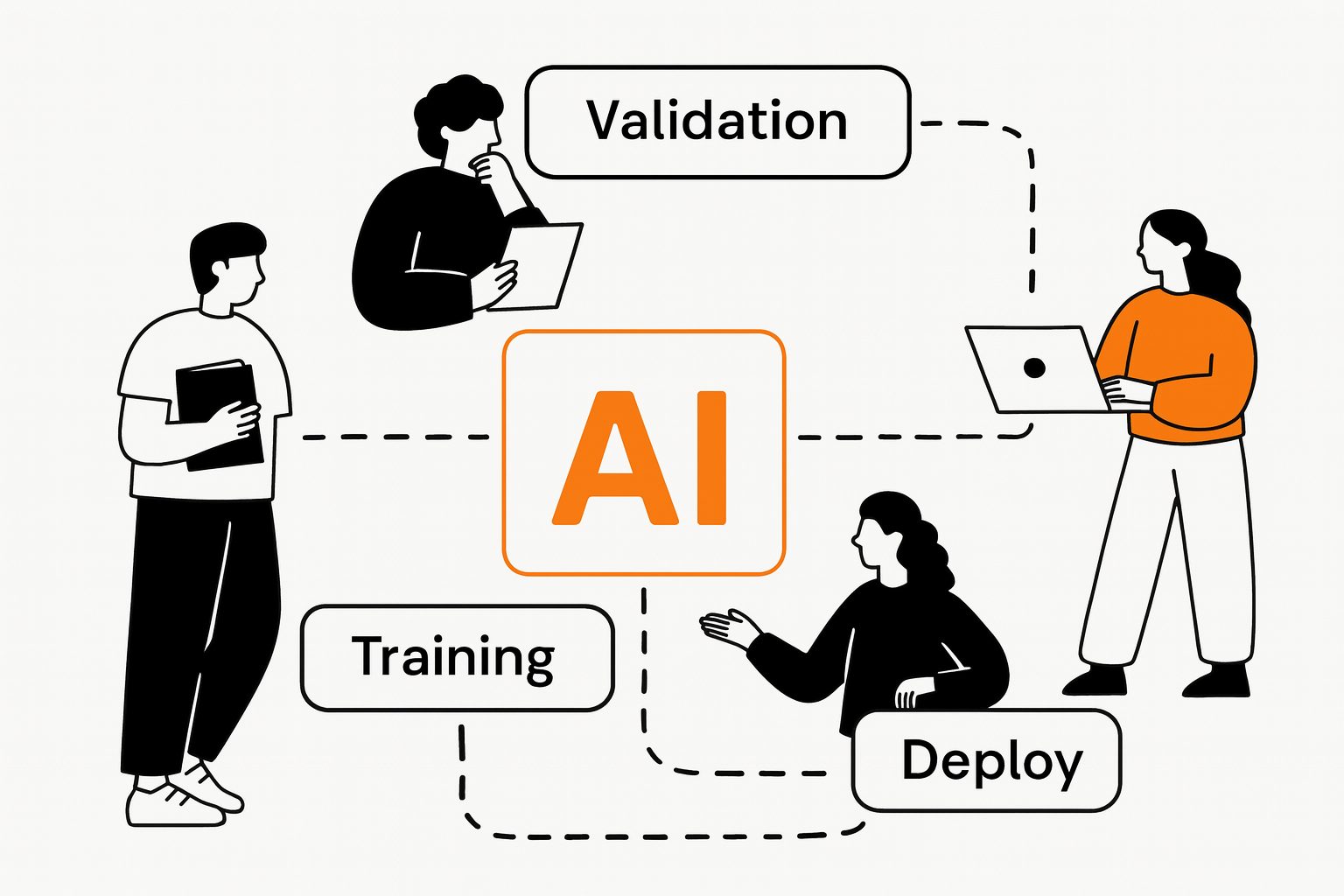Education Technology Landscape in the U.S.: What’s Shaping 2025

The U.S. EdTech landscape is at an inflection point. EdTech platforms leading in AI-driven learning technologies, online education and gamified educational platforms, STEM education, and analytics are pushing the boundaries of digital education, yet they face significant challenges. They find themselves in a complex, constrained market in which innovation, efficiency, and adaptability define success.
For leaders in the EdTech industry, these shifts present a dual challenge: How do you continue innovating while ensuring financial sustainability?
The good news? There are solutions beyond cost cutting and hiring freezes. Below, we explore some of the most effective yet often overlooked strategies for companies in the education sector to develop AI-powered learning tools, learning management systems (LMS), gamified education platforms, and analytics-driven solutions.
The State of the U.S. EdTech Market: Growth Amid Challenges
The global education technology market was valued at $142.37 billion in 2023 and is projected to grow at a compound annual growth rate (CAGR) of 13.4% from 2024 to 2030 (Grand View Research). This growth is fueled by advancements in artificial intelligence (AI), virtual reality, and adaptive learning platforms, which are transforming how students learn and are allowing teachers and entire educational institutions to create more inclusive and personalized education plans.

The Reality Check: Where the EdTech Landscape Stands Today
In previous years, investors were betting big on an “EdTech revolution.” But as markets corrected and interest rates rose, EdTech funding plummeted.
📈 2021: $20.8 billion in global EdTech venture funding.
📈 2023: $2.8 billion in the U.S., returning to pre-pandemic levels.
📈 2024-2025 Outlook: A selective funding environment in which only scalable, high-efficiency models will attract capital.
What This Means for You
◼️ Forget "growth at all costs" – investors are looking for lean, ROI-driven expansion. New technologies enabling efficiency, product-market fit, and modular scaling will stand out.
◼️ Funding still exists – especially for AI-driven learning. Adaptive learning, machine learning-based personalization, and analytics platforms still attract interest.
Solution: Consider hybrid funding models – blending venture capital with revenue-based financing, strategic partnerships, or corporate investments from major EdTech players.
Layoffs and Hiring Freezes: The Impact on EdTech Development Teams
Between the 95,000+ layoffs in tech in 2024 and major workforce reductions at EdTech firms, hiring and retention have changed.
> Coursera cut 10% of its workforce after struggling to expand beyond its core markets.
> Udemy laid off 20% of its staff but planned to rehire some in lower-cost locations.
> Chegg made cuts due to AI-driven competition from ChatGPT and Google AI.
What This Means for You
◼️ Traditional full-time hiring in the EdTech industry is becoming a liability. Hiring cycles are too slow for today’s EdTech environment.
◼️ The talent pool is shifting. Some of the best engineers and AI specialists are now available – but your competitors know this as well.
Solution: Adopt a "just-in-time talent" approach – instead of building static teams, create a flexible network of in-house, external, and dedicated experts who can be deployed based on real-time needs.
Market Consolidation in the Education Technology Sector
Mergers and acquisitions (M&A) are on the rise, as larger companies absorb struggling competitors. 2U, which acquired edX in 2021, has faced multiple rounds of layoffs and financial struggles, even filing for bankruptcy.
What This Means for You
◼️ Scaling intelligently matters more than scaling fast. The global EdTech market favors companies with adaptable, resilient business models over those focused purely on expansion.
◼️ Strategic partnerships can be a growth accelerator. Collaborating with EdTech peers – rather than competing head-on – can unlock new revenue streams, shared development resources, or even acquisition opportunities.
Solution: Explore non-traditional growth avenues.
> License your new technologies to larger platforms rather than competing against them.
> Co-develop solutions with other EdTech firms or universities.
> Create B2B offerings for schools or corporations instead of focusing solely on direct-to-consumer (DTC) models.
Insight: Despite these challenges, the demand for innovative educational solutions remains strong. The K-12 sector, which accounted for over 39% of the EdTech market in 2023, continues to embrace gamification, AI-driven personalized learning, and analytics to enhance student engagement and outcomes. Companies operating in these areas must find ways to scale their development teams and maintain innovation without incurring the high costs of full-time hires
Strategic Moves for Thriving in the EdTech Landscape
History has shown that, when confronted by market disruptions, agile companies that can plan strategically can not only survive the challenges, but can quickly come to dominate their sectors. We’ve identified 3 positions EdTech companies are taking today to set themselves up for a strong future.
Rethink How You Build and Scale EdTech Development Teams
Hiring freezes don’t mean development should stop. Companies that scale strategically – not recklessly – will win in 2025 and beyond.
The Competitive Edge
1. "Modular" development teams – a mix of in-house experts and on-demand specialists.
2. Productivity-focused hiring – filling gaps with specialized contractors rather than committing to full-time salaries.
3. AI & automation-assisted development – reducing dependency on headcount by integrating AI tools into workflows.
Case Study
An AI-driven EdTech startup developing adaptive STEM learning modules needed to accelerate product updates. Given the educational technology landscape, they chose not to hire a full in-house team, and instead:
> Brought in AI specialists on a contract basis for machine learning model improvements.
> Outsourced backend development for specific integrations while keeping core engineers focused on R&D.
> Scaled their team up and down based on product roadmap phases.
The result? Their new AI-powered tutoring system launched 6 months ahead of schedule without the overhead of full-time hiring.
Double Down on Personalization and AI in Learning Processes
If you’re in the EdTech industry, AI is no longer optional. Whether it’s personalized learning paths, gamified retention tools, distance learning, or analytics-driven insights, AI will be the differentiator between companies that survive and those that don’t.
Opportunities
🟧 Gamification, online courses, and AI-driven engagement models increase student retention.
🟧 Predictive analytics can boost learning outcomes – and educational institutions will pay for this.
🟧 Real-time AI tutors will likely replace outdated video-based models in online courses.
What to Do Now
1. Optimize existing AI features before adding new ones.
2. Look for strategic AI partnerships to accelerate innovation.
3. Keep your infrastructure flexible to adopt emerging AI-driven APIs.
Protect Student Data: Cybersecurity Gaps in the EdTech Industry
EdTech companies need to consider active and passive threat vectors, and have appropriate controls in place.
Why This Matters
🟧 The EdTech sector is a prime target for cyberattacks due to sensitive student data.
🟧 FERPA, COPPA, and GDPR compliance are becoming stricter.
🟧 AI-powered cheating detection & security are increasingly in demand.
Actionable Steps
1. Build new systems with cybersecurity in mind from the very start.
2. Bring in cybersecurity expertise on-demand – don’t wait for a data breach.
3. Invest in AI-driven fraud detection tools to protect exams and learning content.
Preliminary Conclusions
Many companies in the EdTech sector are uniquely vulnerable to market fluctuations. They have moved beyond the startup phase but lack the resources of larger enterprises. As they scale, they face several key challenges:
Limited budgets for full-time hires
Given the current landscape of educational technology, funding is tighter than in previous years and companies need to be cautious with their spending. Full-time recruitment is expensive and time-consuming, often taking months to complete.
Need for specialized skills
Developing AI-driven platforms, online courses to enable distance learning, gamified learning experiences, or advanced analytics requires expertise in niche areas such as machine learning, game development, and data science – skills that may not be readily available in-house.
Scaling for growth
Many EdTech companies are experiencing rapid growth, particularly those in high-demand sectors like AI and STEM education. They need to scale their development teams quickly, without sacrificing quality, to meet market demands and investor expectations.

Potential Solution
//: IT staff augmentation offers a flexible, cost-effective solution to these challenges. By partnering with external talent providers, EdTech companies can:
Access specialized skills on demand
Whether it’s AI integration for personalized learning, game development for educational apps, or creating digital clones to enable online learning, augmentation allows companies to bring in experts for specific projects without commitments.
Scale teams efficiently
Augmentation enables companies to scale their development teams up or down based on project needs, avoiding the overhead of maintaining a large full-time staff.
Reduce time-to-market
With external developers ready to onboard quickly, companies can accelerate their product development cycles and meet tight deadlines.
Spotlight on EdTech Companies and Their Needs
To illustrate how staff augmentation can enable companies in the EdTech industry, we’ve developed 4 fictional yet realistic stories of mid-sized EdTech firms in the US These examples illustrate how IT staff augmentation can address common challenges in key sectors.

Startup Crafting Math Adventures
/**/ Sector: Educational Apps & Gamification
/**/ Size: 50-100 employees
Story: A young company, started by a team of game enthusiasts, creates 3D math games for K-6 kids. Its playful approach has caught the eye of educational institutions looking for engaging tools.
/**/ Challenge
Rapid growth means a constant need for new game features, but hiring full-time game developers is costly.
/**/ Augmentation Opportunity
A dedicated development team steps in to build fresh content, letting this startup expand its offerings and stay competitive.

STEM Video Learning Pioneer
/**/ Sector: Coding & STEM Platforms
/**/ Size: 50-100 employees
Story: Launched by a group of STEM advocates, this firm offers a video-based platform to enable online learning and help students master tough subjects like physics and coding. It uses smart tech to tailor videos to each learner.
/**/ Challenge
Integrating AI for personalized content requires skills they don’t have in-house, and hiring experts full-time is out of reach.
/**/ Augmentation Opportunity
IT augmentation brings in AI specialists to boost personalization, enhancing the platform’s appeal without long-term hires.

Student Progress Analytics Trailblazer
/**/ Sector: EdTech Analytics
/**/ Size: 50-100 employees
Story: Born from a mission to support diverse learners, this company develops tools to supplement learning management systems and track student progress for educational institutions. It’s become a go-to for data-driven educators.
/**/ Challenge
As schools demand richer insights, the platform needs more developers to upgrade its reporting features, but budget cuts make hiring tricky.
/**/ Augmentation Opportunity
Augmentation supplies data experts to scale analytics tools, helping this firm meet demand efficiently.
Key Benefits of IT Staff Augmentation for EdTech Companies
Given the current education technology landscape, the advantages of IT staff augmentation for EdTech companies are clear:
Cost-effectiveness
Augmentation avoids the long-term, and often hidden, costs of hiring full-time employees, such as benefits and training. Companies pay only for the talent they need, when they need it.
Flexibility
Teams can be scaled up during peak development periods (e.g., launching a new feature) and scaled down afterward, optimizing resource allocation.
Access to niche expertise
Companies can tap into a global pool of developers with specialized skills in AI, gamification, analytics, online education, and cybersecurity.
Faster time-to-market
With external developers onboarded quickly, companies can accelerate the development cycles for new technologies and bring innovations to market faster.
These benefits are particularly relevant in the current global EdTech market, where funding constraints and workforce reductions have made it difficult for companies to maintain large in-house teams.
Addressing Common Concerns About EdTech Staff Augmentation
While the benefits of staff augmentation are compelling, companies in the EdTech sector may have concerns about integrating external developers into their teams.
Will external developers align with our product vision?
Solution: Choose an augmentation provider that prioritizes seamless integration and collaboration.
How do we ensure security and compliance?
Solution: Partner with firms experienced in FERPA, COPPA, and GDPR compliance to protect student data.
Can augmented teams maintain high-quality standards?
Solution: Establish clear processes, QA guidelines, and performance benchmarks from the start.
How can augmented teams meet the needs of colleges and universities (higher EdTech)?
Solution: Partner with an augmentation provider who can tap into the global EdTech market to find professionals with the right experience.
Conclusion: A Strategic Opportunity for EdTech Companies
The US EdTech market is evolving, and companies need to be able to adapt quickly to survive and thrive. With funding constraints, workforce reductions, and increasing pressure to innovate, traditional hiring models may no longer be sustainable. For EdTech companies navigating an uncertain market, agility is key – and the right staffing approach can be the difference between stagnation and success.
IT staff augmentation, development team scaling, and dedicated development teams offer a strategic, cost-effective solution to drive growth without the risks of over-hiring.
Now is the time to explore //: IT staff augmentation as a growth accelerator. Whether your company is developing AI-powered learning tools, expanding a gamified platform, or enhancing STEM education, flexible talent solutions can help you scale faster, smarter, and more efficiently.

Building Successful AI-Enabled Technology Teams - A Strategic Framework for the Modern Enterprise
Discover how to build successful AI-enabled teams with proven frameworks, AI developers, and talent management strategies for modern software development.

Genius Match Strengthens Leadership Team with Industry Veterans Helen Prashchur and Elizabeth Jenkins
Genius Match announced the appointment of two seasoned sales executives to drive North American expansion.

The AI-Driven Evolution of Software Development: Why Global Talent and Human Expertise Matter More Than Ever
The software development landscape has undergone a seismic shift. AI assistants now write code, automate complex tasks, and streamline development workflows in ways that seemed impossible just a few years ago. While this revolution has transformed how we build software, it has also created new challenges and misconceptions that are reshaping the entire industry.